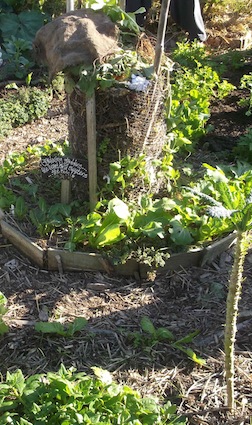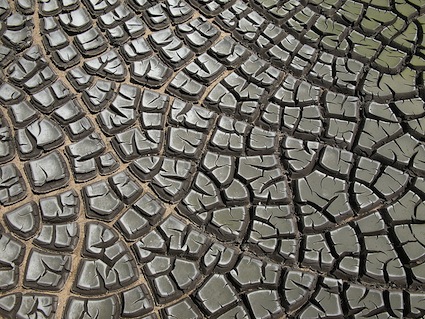Dear Reader, in this age of AI created content, please support with your goodwill someone who works harder to provide the human-made. Sign up in the righthand column or bottom of this page. You will receive my hand illustrated monthly newsletter RESTORE NATURE and access to the biodiversity garden design course as I write...and nothing else, I respect your time.
soil treatment in permaculture
is modeled on nature
 a nature modeled compost tower in Saskia's garden
a nature modeled compost tower in Saskia's gardensoil treatment in permaculture
Soil treatment is my favorite hobby horse, and I come to it last. I love the way permaculture deals with soil management, in modeling itself after the way soil is maintained in nature by natural non-human means.
I learned to do this myself through years of unsuccessful gardening, starting as a child of ten or so in a little square my mom gave me in her garden. It was hidden away behind the outbuildings, and was dominated by one large thorn tree (how little has changed in that regard) and I wanted to plant Greek allysum for its perfume, and the whiff of Mediterranean romance it brought. I watered and watered and the hard (then) Pretoria clay just cracked a little and the allysum mummified on the spot. I comforted myself with Steely Dan "stuck in the middle with you" which was still fresh for me.
The information on soil treatment I am giving last, although the workshop on companion planting in permaculture on which this series of five articles is based started with soil, because it is also a good wrap up, touching on everything we learned. The workshop was given by Saskia Schelling and Karen Parkin, whose contact details you will find below.
the GEODERM, or the soil's organic skin
One idea from permaculture that really makes sense to me is the idea of the geoderm, that the living earth has a skin of organic matter. The earth should never be left bare. Ground covers, mulches, compost, wood-chips or straw, a covered surface, are basic to good gardening and soil management in any horticultural framework. Nonetheless, many gardeners believe in a soil treatment that requires belief in a supernatural principle of purity in their garden, that gardening is about weeding, hoeing and removing the organic skin from the soil, like nothing ever seen in nature, and if its just clean enough everything will flourish. Unfortunately this is what they usually get, its not elephant leather, but undernourished soil. That it may be dotted with sick plants by the well meaning gardener is a bonus for them, but for me detracts from its beauty as a model for nature inspired street layout in high density urbanization.
Three adequately yielding vegetable gardens of my own, and a lifetime of observation of suffering plants in over cleaned up beds, given a soil treatment that amounts to a naked earth policy, underlines the principle of not removing the soil's beauty cream. It makes sense, because in nature, unless there has been a volcano, a landslide, wave action, or flood, in other words a disaster, the soil always rests beneath a protective blanket of fallen leaves and broken bits of organic matter. But saying the soil is protected by a blanket is a misconstruction, like that a city wall would protect the buildings inside. The blanket does not protect the mineral complex of soil as such, but the life within the soil, the billions of tiny life forms per cubic inch without which the soil becomes ‘dead’ and will not unleash its plenitude. Mycelial webs, bacteria, worms, and insects all essential to the soil being fertile, are killed by nakedness. It is logical because irradiation, desiccation, and excess heat are not life friendly forces. The best soil treatment is to litter the soil with organic debris. Don't remove and burn weeds, drop them where you pulled them up. You'll have less trouble in the long run, as the lifetime professional gardener at Irma Stern museum, Jonathan Fritz observed.
plants which conserve soil
A plant in Saskia's garden which is beneficial for repelling insects and for soil conservation is Chrysopogon zizanioides, or the Vetiver grass mentioned earlier. It is closely related to sorghum, puts down deep roots rather than shallow stolons or rhizomes, like most grass, and is thus soil stabilizing and very drought resistant. The perfumed oil extracted from its roots is used for Ayurvedic soap. A vegetatively reproducing non fertile strain is what one sees propagated worldwide. It is also a good “cut and drop” crop according to Saskia. Like the nutritious comfrey, snip off a leaf and let it fall and it will feed the earth beneath.
Rosemary is also apparently soil stabilizing due to its large root system. When planning a herb garden or vegetable garden these beneficial factors can be incorporated. Take note of further functional uses of herbs in the following.
soil cover doubles as organic fertilizer
There are ground covers for blanketing the soil, for which strawberries, sweet potatoes, Sutera and thyme were used in this garden. Beyond groundcovers, mulches of wood chips, leaves, straw (which Saskia uses extensively in her garden) and manure add organic material and slowly released nutrients to the soil. The compost tower pictured above uses the decomposing compost and the peas clambering on it to see to the needs of the heavy feeding lettuce and cabbage.
activating your garden soil
Permaculture advocates special soil treatment to activate the life in the soil. You can scatter volcanic rock, rich in minerals, or straw which adds organic matter to the soil and thus improves soil structure and water and nutrient retention, or earthworms can be added which burrow, aerate, and exude substances beneficial to your plants, or you can apply manure which adds nitrogen and a rich palette of microbes, or plant yarrow, borage, and nitrogen fixing legumes. Saskia’s soil has been improved for 3 years, by the non dig method, using only successive layering of organic matter. Another great idea specifically for our oily Cape sand is to put a submerged pot full of holes, or a plant pot in the middle of a bed. Water into the pot, and it takes the water down to deeper depths than surface watering can. It also prevents surface evaporation, saving water, and prevents the damage caused by a jet of water on loose dry soil.
Thus ends the last article in the mini series of five on companion planting in permaculture. They dealt with plant guilds, antagonism and beneficial plants, planting up a vegetable garden, and pests in an organic garden.
I must sincerely thank the women who put on this workshop, Saskia Schelling (saskia@gardencoach.co.za) and Karen Parkin (permaperson@gmail.com) who provided a stimulating garden classroom where I learned a lot, even after a lifetime of gardening and two years in horticulture school. I can only recommend visiting Saskia's "lab" or garden, when the next offering is presented. It is also a wonderful opportunity to network and just relax, thoroughly and definitely money well spent.
------
Return from "soil treatment" to the home page for other green ideas
------
saving your soil and the planet with it
------
vegetable gardening the natural low cost way
------
gardening and where it all started
------
link back to the first companion workshop page on plant guilds
------
link to the previous companion planting page on pests
You’re a home gardener ! Share your experiences and questions !
We all know about home gardening. Tell us about your successes, challenges and ask about issues that bother you. You may have the luxury of a back garden, but there are other ways we learn. Few people age without growing something or buying vegetables during their lives ! It is absolutely guaranteed that you have learned things which can help others on their gardening journey.
We invite you to share your stories, ask questions, because if a thing has bothered you it will bother others too. Someone may have a solution ! No question is too small. There is learning for everyone involved, for you, for me (yes, I learn from every question), for us all. Exciting stuff !
We are starting on a new journey. Every week we will profile your letters ! The best stories and questions we receive.
Restore Nature Newsletter
I've been writing for four years now and I would love to hear from you
Please let me know if you have any questions, comments or stories to share on gardening, permaculture, regenerative agriculture, food forests, natural gardening, do nothing gardening, observations about pests and diseases, foraging, dealing with and using weeds constructively, composting and going offgrid.
SEARCH
Order the Kindle E-book for the SPECIAL PRICE of only
Prices valid till 30.09.2023
Recent Articles
-
Geography Research Task
Jan 31, 25 11:37 PM
To whom it may concern My name is Tanyaradzwa Madziwa and I am a matric student at Springfield Convent School. As part of our geography syllabus for this -
Eco Long Drop Pit Latrines Uganda
Nov 29, 24 02:45 AM
Good evening from the UK. My name is Murray Kirkham and I am the chairman of the International and foundation committee of my local Lindum Lincoln Rotary -
Landscape Architect
Oct 01, 24 10:42 AM
I so appreciate your informative description! Your experimentation and curiosity with the seeds, germination, and rearing of the maggot are exciting to
"How to start a profitable worm business on a shoestring budget
Order a printed copy from "Amazon" at the SPECIAL PRICE of only
or a digital version from the "Kindle" store at the SPECIAL PRICE of only
Prices valid till 30.09.2023






